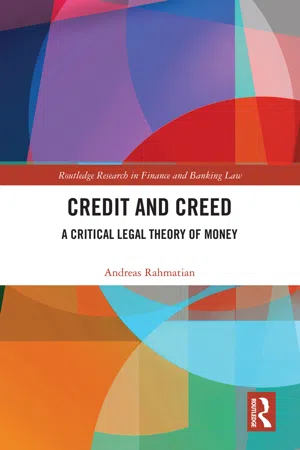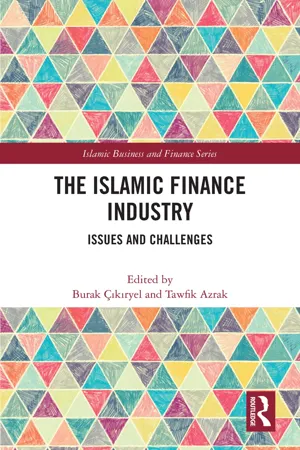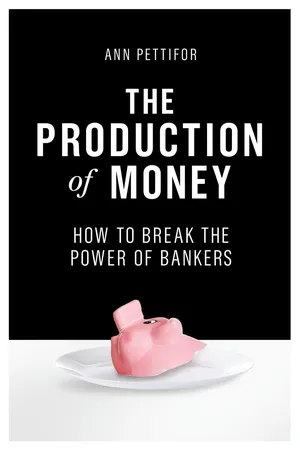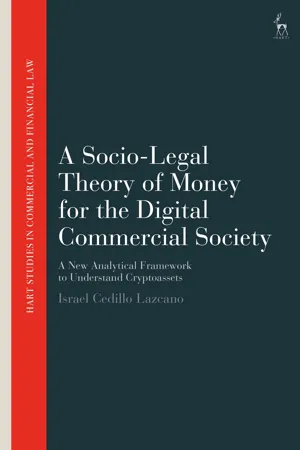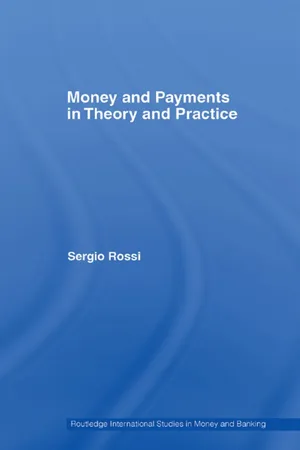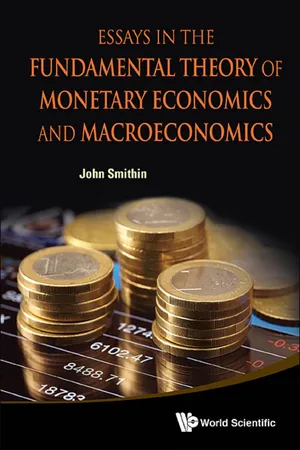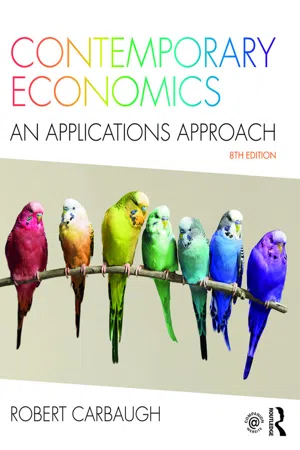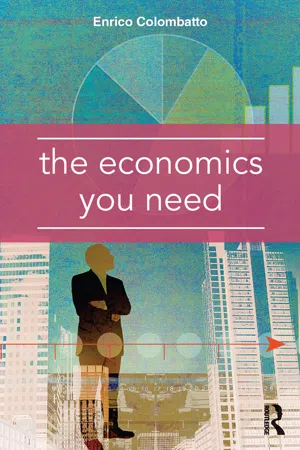Economics
Money Creation
Money creation refers to the process by which the banking system generates new money through the issuance of loans. When a bank extends a loan, it effectively creates new money by increasing the borrower's deposit balance. This expansion of the money supply plays a crucial role in stimulating economic activity and influencing overall price levels.
Written by Perlego with AI-assistance
Related key terms
9 Key excerpts on "Money Creation"
- eBook - ePub
Credit and Creed
A Critical Legal Theory of Money
- Andreas Rahmatian(Author)
- 2019(Publication Date)
- Routledge(Publisher)
2The creation of money and its legal basis 11 This chapter is based on Rahmatian (2018a: 205–236) and follows this article to a large extent.1. Theories of Money Creation or money supplyCreation of money, or more broadly, money supply, is usually seen as a fairly straightforward affair by the general public. In a layperson’s view ‘money’, first and foremost cash, comes particularly from central banks in form of banknotes, and commercial banks record the (cash) deposits by their customers as bank money in their accounts2 – these deposits out of which the commercial banks then grant loans. This incorrect opinion, generally held by laypeople, including politicians, can then lead to unfortunate economic policy decisions as a result of insufficient understanding of the true situation. To the credit of the nonspecialists, however, one has to emphasise that the interpretation of the money supply process has long been controversial, and if one looks at economics textbooks, many economists still do not seem to comprehend it fully. Lawyers, in turn, do not attempt an appreciation of the money supply process because they regard that issue as part of the domain of economics.32 See e.g. the amusing story by Hudson (2013: 893) for an illustration of his own belief as a boy.3 See discussion of this problem in Chapter 1.Three theories have been advanced for the explanation of the money supply process: (a) the financial intermediation theory of money, (b) the fractional reserve theory, and (c) the credit creation theory of money.44 See also literature review on these theories by Werner (2014b: 2–12) and Werner (2016: 362–370).(a) Financial intermediation theory of moneyThe financial intermediation theory of money comes closest to the layperson’s view sketched out above. According to this theory, banks obtain deposits from customers and lend these to borrowers. Thus banks borrow from their depositors with short-term maturities and lend to other customers in form of long-term loans. In such an arrangement banks are only financial intermediaries and do not differ from other non-bank financial institutions. Banks supply money; they do not create it. This view is plausible to non-specialists, but economists should realise that such an organisation of banks’ lending practice could soon lead to liquidity problems of banks or even their collapse if banks are really just intermediaries. And lawyers should notice that the idea that banks are not different from non-bank financial institutions would simply be against the law: as will be detailed below, non-banks taking a deposit or client money have to keep it in a separate client account while banks do not have this legal requirement. Nevertheless, prominent economists have supported the financial intermediation theory,5 for example Keynes, at first more tentatively in his Treatise on Money (1930):6 - eBook - ePub
The Islamic Finance Industry
Issues and Challenges
- Burak Çıkıryel, Tawfik Azrak, Burak Çikiryel, Tawfik Azrak(Authors)
- 2023(Publication Date)
- Routledge(Publisher)
Rochon & Rossi, 2013 ). The developments in the last two stages enhance bank lending in one hand, while introducing their own constraint on the other hand.Here we see two theories coming forward: financial intermediation theory and fractional reserve theory (money multiplier) of banking. However, McLeay et al. (2014) underline two misconceptions about Money Creation: one is that banks act simply as intermediaries, lending out the deposits of depositors. The other one is that the central bank determines the quantity of loans and deposits in the economy by controlling the quantity of central bank money, which is the money multiplier theory. There is another theory, credit creation theory, according to which individual banks create credit in the form of deposits without solely lending out customers’ deposited money (Werner, 2014 ).3 Money Creation Process
Banks’ deposit multiplication according to fractional reserve theory is shown in Figure 2.1 . According to this theory, when money is deposited to a bank, the bank keeps a fraction of this deposit as a reserve requirement, which is imposed by the central bank and generally called required reserve ratio. We assume the required reserve ratio is 10%, all banks make loans for the full amount of their excess reserves, and the public prefers to keep all their money in deposits rather than carrying cash. At t=0, $100 is deposited to Bank A by a depositor, which increases Bank A’s reserves and deposit accounts to $100. At t=1, Bank A lends out $91 and keeps the remaining $9 in its reserves. The borrower then spends the money for buying something, and the seller (because of zero cash preference) deposits it in his deposit account at Bank B. This procedure repeats itself at each step and eventually at t - eBook - ePub
The Production of Money
How to Break the Power of Bankers
- Ann Pettifor(Author)
- 2017(Publication Date)
- Verso(Publisher)
private banking system. Rather than banks acting as intermediaries and lending out deposits that were placed with them, it is the act of lending itself that creates deposits or bank money, and is also a debt, the Bank’s staff explained. Of course this bank money is not actually printed by the private bank; only the central bank has the legal authority to print money and mint coins. The money created by a loan – bank money – is simply digitally transferred from one private bank account to another. The only evidence of its existence is in the numbers printed on a bank statement. Of the total amount of money created, only a tiny proportion is normally converted into tangible money in the form of notes and coins, or cash.For private commercial bankers operating within a monetary economy, the relevant consideration is not the availability of existing savings, but the viability of the borrower, her project, her collateral and the assessment of whether the project will generate income with which she can repay the credit/debt.And yes, the Bank of England confirmed that in a monetary economy the money multiplier (the percentage of deposits that banks are required to hold as reserves against lending) is an incorrect account of the lending process. Bank lending is not constrained by ‘reserves’. The assumption that banks hold reserves equal to a fraction of their lending – ‘fractional reserve banking’ – is wrong. Bank ‘reserves’ are not savings in the sense we understand them. They are resources (resembling an overdraft) made available only to the bankers licensed by the central bank. They are used to facilitate the ‘clearing’ process for settling deposits and liabilities between banks at the end of each day. Central bank reserves never leave the banking system to enter the real economy. While central bank reserves may help to free up the balance sheets of banks and other associated financial institutions, they cannot be used to lend on to firms or individuals in the non-bank economy. - eBook - ePub
Money
What It Is, How It's Created, Who Gets It, and Why It Matters
- Sergio M. Focardi(Author)
- 2018(Publication Date)
- Routledge(Publisher)
In summary, the endogenous Money Creation theory holds that money is created by commercial banks without the intervention of the central bank. The central bank intervenes only to provide reserves so that regulatory standards are met and it is possible to make transfers of funds between banks. In this view, banknotes play no role in the money generation process. Banknotes are supplied to individuals on demand but do not influence the total money generation process. An endogenous money generation process can start from zero with banks making loans and creating deposits. This is a fundamental difference with the verticalist theory which holds that the money generation process depends on exogenous money supplied by central banks and multiplied (but not created) by commercial banks. The main difference is given by the handling of reserves and by the role of currency.5.6 Other ways to create money
In addition to the creation of money or near-money that we have discussed thus far, there are additional ways to create purchasing power, including private credit and the issuing of digital currencies. The purchasing power thus created does not always qualify as money.5.6.1 Private creditWe have discussed the role of commercial banks in creating money by issuing loans. But commercial banks are not the only ones to accord credit or issue loans. There are two other commonly used ways to accord credit: commercial payment terms and peer-to-peer lending.In according payment terms to their business partners, firms extend credit to clients, thereby according them increased purchasing power. Consider, for example, clothing stores. Typically shops order goods well in advance of the season when products can be sold and, at the beginning of the season, keep inventory. Modern techniques of flexible production allow just-in-time delivery of products on short notice but, still, any clothing store must keep a minimum of inventory. It makes a difference if the supplier insists on being paid on delivery, within say 60 days, or only in the case of a sale, accepting to take back unsold inventory. By increasing the purchasing power of clients, commercial payment terms are loans and fulfill one of the key functions of money. However, firms that give favorable payment terms are using their own money or reducing their own credit and, ultimately, their own purchasing power. The sum of credit/ debt is zero. - eBook - ePub
A Socio-Legal Theory of Money for the Digital Commercial Society
A New Analytical Framework to Understand Cryptoassets
- Israel Cedillo Lazcano(Author)
- 2024(Publication Date)
- Hart Publishing(Publisher)
168Thus, one cannot say that saving, by itself, creates funds available for banks to lend.169 When a bank receives a loan application, it does not peer into its vault to determine the quantity of depositors’ funds are on hand to lend to third parties, as described in United Dominions Trust v Kirkwood,170 and it does not typically do so by giving them thousands of pounds’, dollars’ or pesos’ worth of banknotes.171 In practice, banks hold only cash enough to process their legal obligations – eg those that derive from the Basel Accords – and, under a FMC model, they fund new loans by creating new ledger-entry deposits for their borrowers, through ‘transactions that involve a single-cum-depositor and no saver’.172 For this reason, James Tobin173 put the ‘money created by bankers’ fountain pens’ and the ‘money created by public printing presses’ at the same level. Through this new lending, the balance sheets of different sectors of the economy are affected. In the books, this transaction appears as an asset and a liability of the bank as described with detail in Folley v Hill,174 on the one hand, and an asset and a liability of the borrower, on the other.175Figure 5 Balance sheet of commercial banks and consumers during the process of broad Money Creation176Figure 5 shows us how, in principle, banks create their own funding in the act of lending. No real resources are diverted from other uses in order to be able to lend to a new customer. This purchasing power is injected into the economy independently of the economy’s pre-loan income flow.177 In simpler terms, what is needed in an FMC model from third parties is not a deposit of tangible assets, but the acceptance of the new dematerialised purchasing power in payment for physical resources.178 - eBook - ePub
- Sergio Rossi(Author)
- 2007(Publication Date)
- Routledge(Publisher)
ex nihilo. The credit that a bank may grant to a firm is therefore related substantially to production. It is production that makes it possible for income to exist and to be lent to banks’ borrowers. Yet, without banks, no income would be produced, as no credit would be available for firms to pay out the relevant amount of wages. To explain credit, it is therefore necessary to explain both the emission of money and the financial intermediation carried out by banks in any payment they issue, starting logically with the payment of production costs, which is an income-generating operation, as we shall better understand in the next chapter.Before moving on, however, there remains an issue to be discussed in this chapter. In fact, according to traditional analysis, the credit supply is and can be controlled by the central bank, which affects the money stock, M, via the base money multiplier, m, as epitomized by the textbook formula M = mB, where B represents the monetary base (labelled high-powered money) supplied by the central bank. Banks would therefore be able to grant credit to the extent that they have enough reserves of liquidity, in the form of high-powered money (as in fractional reserve banking). The supply of credit would thus depend on the supply of money, which would itself depend on central bank policy. We will consider this issue as a gambit to Chapter 2.Money and credit supply
Generally speaking, the textbook story admits that banks create money – in the form of deposits, D – as a multiple of central bank money. This story, however, sets off from the traditional hypothesis that the monetary base is an exogenous variable, like the reserve-to-deposit ratio R/D, and the currency-to-deposit ratio C/D, both ratios entering the determination of m - John Smithin(Author)
- 2013(Publication Date)
- WSPC(Publisher)
This was extremely important historically in the actual genesis of capitalism (Ingham, 2004; Kim, 2011), and there is no question of the state ever going bankrupt as it is the issuer of the money. 5 There could still be problems, however, due to the reaction of those politicians who are concerned about this sort of thing as is confirmed in real world politics every day. There might be calls to return to a “balanced budget”, “sound finance”, “fiscal responsibility”, “austerity”, etc., thereby threatening, in effect, to shut everything down. Those in the society who already do have some money holdings (bank deposits) in place, of course, might also point to the opposite danger, that the budget deficit might become be too large, too much money (from their point of view) might be created and existing wealth devalued through inflation. The last statement brings up the completely general point that for the money profits to be “real” (using this term now in the sense of “not inflationary”) M′ > M must stimulate production in “value” or “volume” terms, that is C′ > C, to the same extent. If the volume of commodities, C, stays constant there is no actual value-added production and M′ > M will only mean a rise in money prices. Credit creation is therefore a necessary, but not suffcient, condition for the existence of real profit. Presumably, it is this sort of thing that those who complain about “excessive” credit creation, propose to strictly limit the quantity of money, or worry about the “deficit” must be thinking. However, this way of looking at the problem is misguided. A binding restriction on the size of the money supply would only lead to more economic problems. There is no incentive for production to place at all (no incentive for anyone to take action to expand the value of commodities to C′), unless there are indeed some money profits to be made- No longer available |Learn more
Contemporary Economics
An Applications Approach
- Robert Carbaugh(Author)
- 2016(Publication Date)
- Routledge(Publisher)
The company buys $900 of equipment from another firm, which deposits the check in its account at U.S. Bank. Figure 14.4 (b) shows what happens to the balance sheet of U.S. Bank. Its checking deposits increase by $900 as a result of the deposit. The bank must maintain $90 of required reserves ($900 × 0.10 = $90) and it can lend out $810. Suppose that the bank lends $810 to the owner of an espresso stand and opens a checking account for him. In this way, U.S. Bank creates an additional $810 of money. The espresso stand owner then purchases supplies from a wholesaler who deposits the check in her account at Rainier Bank, which keeps $81 in reserve ($810 × 0.010 = $81) and makes $729 in loans. Figure 14.4 (c) shows what happens to the balance sheet of Rainier Bank. The process goes on and on. Each time we deposit a check and a bank makes a loan, more money is created. We can determine how much money is eventually created by the banking system by adding the money created by each bank: The process of Money Creation can continue forever. If we added the infinite sequence of numbers in our example, we find that the initial checking deposit of $1,000 results in a total money supply of $10,000. Put simply, the money supply of the banking system can be increased by a multiple of the initial checking deposit. 5 5 The basic money supply (M1) is the sum of currency held by the public plus checking accounts issued by banks. Thus, the change in the money supply equals the change in currency held by the public plus the change in checking accounts. Although in our example of Money Creation checking accounts increased by $10,000, the public now has $1,000 less currency because they deposited the currency in the bank. The money supply thus increased by $9,000 ($10,000–$1,000 = $9,000). We call the maximum amount of money that the banking system can generate with each dollar of reserves the money multiplier - eBook - ePub
- Enrico Colombatto(Author)
- 2016(Publication Date)
- Routledge(Publisher)
In other words, there is no ideal definition of money supply, in that there is no a priori reason to argue that M0 is a better/worse measure than, say M1 or M2. We can only alert the reader to the fact that when the media refer to changes in the money supply with no further qualifications, they usually mean M2. And when they refer to the ‘money multiplier’, they actually mean the M1/M0 or the M2/M0 ratio.7.6 Getting closer to the real world: central banking
The second element refers to the creation of central banking. By and large, a central bank can play two roles, depending on statutes. It can operate as the banks’ bank, i.e. the institution in which commercial banks deposit their assets or from which they borrow money. And it can also be a government agency with privileges and law-making power (including monopoly of note issue and regulation).In truth, a monetary system that operates according to the guidelines described in the previous section does not really need a banks’ bank, except perhaps for the purpose of pooling resources and developing an interbank insurance system. For example, given a fractional reserve system (R<100 per cent), a commercial bank subject to the depositors’ unpredictable demand for cash might need to adopt a relatively high reserve ratio R1 , even when it knows it needs only R2 on average (with R2 <R1 ). By pooling reserves, however, the shocks of unpredictable demand are absorbed by the whole banking system, so that each bank needs to keep in store only R2 at all times. Similarly, banks might agree to create a reserve fund that would guarantee depositors against a single bank's failure, possibly monitor at least part of the banks in activity, and inform the depositors accordingly. Under these circumstances, the name on the building hosting the common vault, the common insurer, and the supervisors might well be ‘bankers’ bank’ or ‘central bank’.However, the role of the central banker might change drastically in a scenario in which one believes that monetary and credit matters should not be left to the unfettered interaction of individuals – depositors, bank managers, borrowers; that an appropriate regulatory corset should be enforced; and that a dedicated agency should be in charge. Such an agency is indeed the central bank, to which the government gives the power and duty to verify the truthfulness of the banks’ balance sheets, and of their compliance with the laws of the country; the power to determine the minimum reserve ratio, so as to reduce the risk of banks’ insolvency; and, since the end of the gold standard, the privilege of printing fiat money with legal-tender status. We now turn our attention to this last topic, fiat money and legal tender, which are indeed critical features of today's economies.
Index pages curate the most relevant extracts from our library of academic textbooks. They’ve been created using an in-house natural language model (NLM), each adding context and meaning to key research topics.
